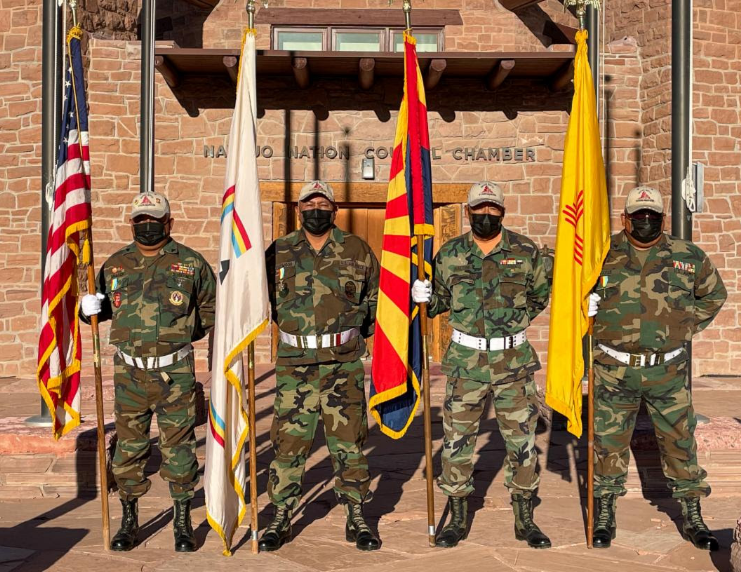
- Details
- By Levi Rickert
Today on Veterans Day, we honor the men and women who have served in the United States Armed Forces. Commemorated annually, Veterans Day originated as “Armistice Day” on November 11, 1919, the first anniversary of the end of World War I. Then President Dwight D. Eisenhower signed legislation in 1954 that changed the name to Veterans Day. It is a national holiday that honors all veterans—alive and dead—who have served the United States in the military.
For over 200 years, Native Americans have fought valiantly in the United States military even before Native Americans gained U.S. citizenry in 1924.
The rich contributions of the Native American code talkers during World War II have been chronicled in recent years. The fact that their codes were never broken is witness to the power of Native language that was available to those who spoke it then. One irony of history is Native languages that helped to save democracy during World War II were, at one point, beaten out of many of that generation at Indian boarding schools. Thankfully, the language survived.
Known as warriors throughout history, that deep tradition has continued for Native Americans into modern times. The Pentagon reports American Indians and Alaska Natives (AIAN) participate in the military at a higher rate than any other racial or ethnic group in the United States.
Watching Native American honor veterans carry eagle staffs and flags into the dance circle during grand entries at powwows is breathtaking and a powerful experience. The power of the drum, coupled with the brilliance of the eagle feathers and colorful flags still cause a tremendous moment of remembrance to their service. They represent well because they served our country well.
The Office of Tribal Governmental Relations at the Veterans Administration sent Native News Online on Wednesday the latest statistics from 2017 on AIAN service to the United States military. Prepared by the Department of Veterans Affairs’ (VA) National Center for Veterans Analysis and Statistics,
The report analyzed American Indian/Alaska Native (AIAN) veterans.
- 88.7 percent of Native veterans are men and 11.3 percent, women.
- Native veterans were more likely to live in the West region of the United States than Veterans of other races.
- Native veterans’ median age was 59 while the median age for non-native veterans was 41.
- Native veterans served before 9/11 at a higher percentage than Veterans of other races.
- Native veterans had lower personal incomes than veterans of other races.
- Native veterans were more likely to have some college compared to veterans of other races.
- The percentage of Native Veterans who were unemployed was higher than the percentage of veterans of other races who were unemployed.
Native veterans were more likely to lack health insurance than Veterans of other races.
The percentage of Native veterans with no health insurance (7.4 percent) was more than twice that of all other race veterans (2.9 percent).
With all the praise we offer veterans on Veterans Day, many veterans lack basic services for health care and too many are homeless. These veterans who sacrificed so much, deserve much more.
Today, Native News Online honors all warrior veterans and says “megwetch” (thank you) for all you did for this country.
Editor's Note: This article was originally published on Veterans Day, November 11, 2021.
More Stories Like This
Colorado cannot heal until it confronts Sand Creek honestlyNative American Mothers Deserve to Live
Technology Rooted in Tradition is Strengthening Cherokee Nation
The Lumbee Tribe of North Carolina: #575
Tribes Do Not Need a Greenlight to Build Renewable Energy
Help us defend tribal sovereignty.
At Native News Online, our mission is rooted in telling the stories that strengthen sovereignty and uplift Indigenous voices — not just at year’s end, but every single day.
Because of your generosity last year, we were able to keep our reporters on the ground in tribal communities, at national gatherings and in the halls of Congress — covering the issues that matter most to Indian Country: sovereignty, culture, education, health and economic opportunity.
That support sustained us through a tough year in 2025. Now, as we look to the year ahead, we need your help right now to ensure warrior journalism remains strong — reporting that defends tribal sovereignty, amplifies Native truth, and holds power accountable.
 The stakes couldn't be higher. Your support keeps Native voices heard, Native stories told and Native sovereignty defended.
The stakes couldn't be higher. Your support keeps Native voices heard, Native stories told and Native sovereignty defended.
Stand with Warrior Journalism today.
Levi Rickert (Potawatomi), Editor & Publisher


